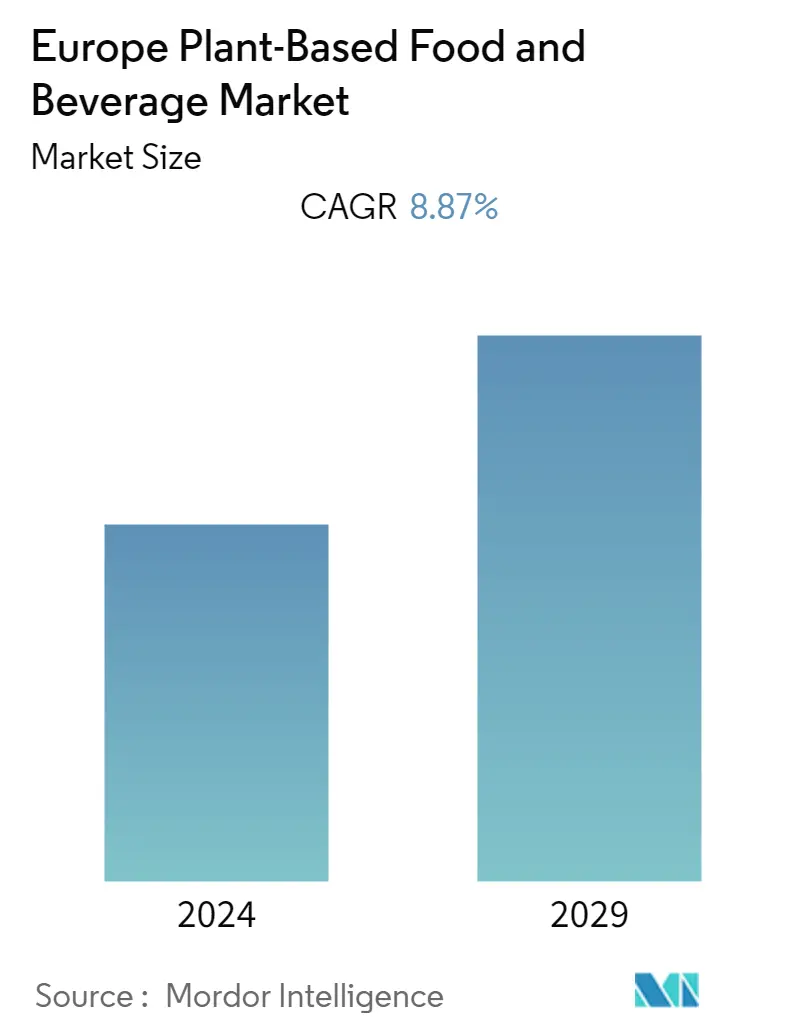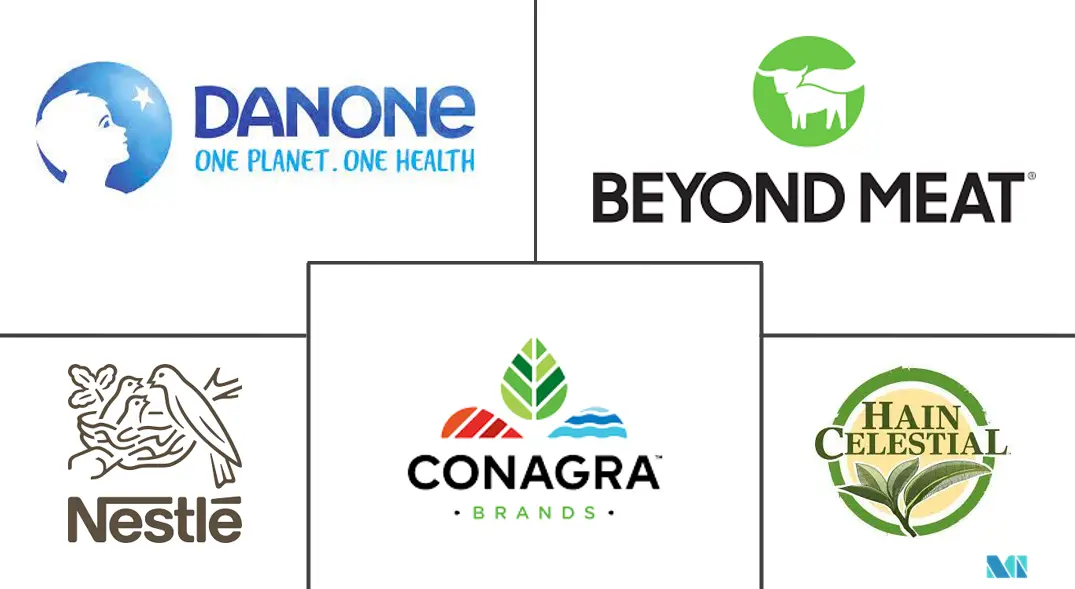Market Size of Europe Plant-Based Food and Beverage Industry

| Study Period | 2020 - 2029 |
| Base Year For Estimation | 2023 |
| Forecast Data Period | 2024 - 2029 |
| Historical Data Period | 2020 - 2022 |
| CAGR | 8.87 % |
| Market Concentration | Low |
Major Players
*Disclaimer: Major Players sorted in no particular order |
Europe Plant-based Food and Beverages Market Analysis
Europe's plant-based food and beverage market is projected to grow at a CAGR of 8.87% over the next five years.
The popularity of the vegan diet and incidences of lactose intolerance drive the European plant-based food and beverages market. The rising consumer awareness regarding meat consumption's negative impact on health is leading to a shift toward a vegan diet and declining meat consumption. For instance, according to the Office for National Statistics (UK), in 2021, consumer spending on meat was at approximately 20.54 billion British pounds, which decreased from 20.78 billion British pounds in 2020. Additionally, the benefits of cholesterol-free protein, with a meat-like texture, are one of those critical factors promoting the growth of plant-based food and beverages.
Increased launch of unconventional dairy alternative products, such as hemp, pea, and cashew milk, is an optimistic development for the market. This is expected to drive the market in the future, as most manufacturers are making developments in the sector. For instance, in July 2021, Linda McCartney's, one of the UK's darling meat-free brands, launched its plant-based milk line. Linda McCartney's range comprises a barista oat, barista coconut, soy, and rice milk. Furthermore, there is a significant improvement in media coverage, which is primarily in line with the increase in new product developments and the demand for products.
However, the comparatively high prices of dairy alternatives pose a challenge to the market. The presence of nutritionally equivalent options for a lower price is expected to affect consumer behavior and refrain from purchasing dairy alternatives.
Europe Plant-based Food and Beverages Industry Segmentation
Foods and beverages "plant-based" contain only plant-based ingredients, such as fruits, vegetables, whole grains, legumes, nuts & seeds, herbs, and spices. These products don't include any animal-based products in them. The market studied is segmented based on product type, distribution channel, and country. Based on product type, the market " is segmented into meat substitutes, dairy-alternative beverages, non-dairy ice cream, non-dairy cheese, non-dairy yogurt, and non-dairy spreads. Dairy-alternative beverages are further segmented into soy and other drinks. almonddrinksSimilarly, meat substitutes are further segmented as textured vegetable protein, tofu, tempeh, and others. By distribution channel, the market studied is segmented into supermarkets/hypermarkets, convenience stores, online
media, and other distribution channels. The report also analyzes the Europe plant-based food and beverages market in emerging and established countries such as the United Kingdom, Germany, France, Italy, Spain, and the rest of Europe. The report offers market size and forecasts for the market in value (USD million) for all the above segments.
| By Product Types | ||||||
| ||||||
| ||||||
| Non-dairy Ice Cream | ||||||
| Non-dairy Cheese | ||||||
| Non-dairy Yogurt | ||||||
| Non-dairy Spreads |
| By Distribution Channel | |
| Supermarkets/Hypermarkets | |
| Convenience Stores | |
| Online Retail Stores | |
| Other Distribution Channels |
| By Country | |
| United Kingdom | |
| Germany | |
| France | |
| Italy | |
| Spain | |
| Rest of Europe |
Europe Plant-Based Food and Beverage Market Size Summary
The European plant-based food and beverages market is experiencing significant growth, driven by increasing consumer awareness of health impacts associated with meat consumption and a rising interest in vegan diets. This shift is further supported by the growing prevalence of lactose intolerance, particularly in Northern European countries, which has expanded the market beyond just vegans to include flexitarians and those seeking clean-label options. The market is characterized by a surge in product innovation, with companies launching a variety of dairy alternatives such as hemp, pea, and cashew milk. Major brands and new entrants alike are focusing on expanding their product portfolios to capture a larger market share, responding to the demand for cholesterol-free, meat-like protein alternatives.
The market landscape is fragmented, with both established players like Nestle SA, Danone SA, and Conagra Brands, and emerging regional companies such as Upfield and AMIDORI Food Company GmbH & Co. KG, contributing to the competitive environment. These companies are leveraging product launches as a key strategy to maintain and grow their market presence. The introduction of new products, such as vegan snacks and beverages, is a testament to the increasing consumer demand for plant-based options. Despite challenges like the higher cost of dairy alternatives, the market continues to expand, supported by innovative offerings and strategic partnerships, such as Oatly's collaboration with Deutsche Bahn to provide plant-based milk on trains.
Europe Plant-Based Food and Beverage Market Size - Table of Contents
-
1. MARKET DYNAMICS
-
1.1 Market Drivers
-
1.2 Market Restraints
-
1.3 Porter's Five Forces Analysis
-
1.3.1 Threat of New Entrants
-
1.3.2 Bargaining Power of Buyers/Consumers
-
1.3.3 Bargaining Power of Suppliers
-
1.3.4 Threat of Substitute Products
-
1.3.5 Intensity of Competitive Rivalry
-
-
-
2. MARKET SEGMENTATION
-
2.1 By Product Types
-
2.1.1 Meat Substitutes
-
2.1.1.1 Textured Vegetable Protein
-
2.1.1.2 Tofu
-
2.1.1.3 Tempeh
-
2.1.1.4 Others
-
-
2.1.2 Dairy Alternative Beverages
-
2.1.2.1 Soy Milk
-
2.1.2.2 Almond Milk
-
2.1.2.3 Other Dairy Alternative Beverages
-
-
2.1.3 Non-dairy Ice Cream
-
2.1.4 Non-dairy Cheese
-
2.1.5 Non-dairy Yogurt
-
2.1.6 Non-dairy Spreads
-
-
2.2 By Distribution Channel
-
2.2.1 Supermarkets/Hypermarkets
-
2.2.2 Convenience Stores
-
2.2.3 Online Retail Stores
-
2.2.4 Other Distribution Channels
-
-
2.3 By Country
-
2.3.1 United Kingdom
-
2.3.2 Germany
-
2.3.3 France
-
2.3.4 Italy
-
2.3.5 Spain
-
2.3.6 Rest of Europe
-
-
Europe Plant-Based Food and Beverage Market Size FAQs
What is the current Europe Plant-Based Food and Beverage Market size?
The Europe Plant-Based Food and Beverage Market is projected to register a CAGR of 8.87% during the forecast period (2024-2029)
Who are the key players in Europe Plant-Based Food and Beverage Market?
Danone SA, Hain Celestial Group, Inc, Conagra Brands, Inc., Beyond Meat, Inc. and Nestle SA are the major companies operating in the Europe Plant-Based Food and Beverage Market.

